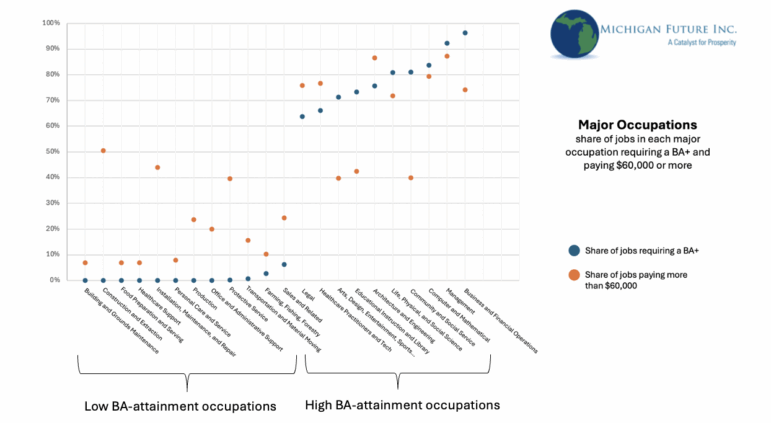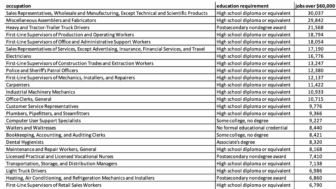We recently conducted a webinar presenting our analysis of the latest occupation and wage data on the Michigan economy, released by the Bureau of Labor Statistics. The data reveal a two-tiered economy in Michigan. There is one set of occupations where most jobs do not require a bachelor’s degree, and where most jobs are low-paying. And then there is another set of occupations where most jobs require a bachelor’s degree, and most jobs pay middle to high wages. This two-tiered economy is captured in the dot chart below. For each occupational category, the blue dot shows the share of jobs in that occupational category that require a bachelor’s degree, and the orange dot shows the share of jobs in that occupational category that pay $60,000 or more.

The dot chart is the best encapsulation of the Michigan economy today. Below are eight additional takeaways that describe Michigan’s two-tiered labor market.
Takeaway #1: 6 out of every 10 Michigan jobs pay less than $60,000. Most Michigan jobs do not pay high wages. This should have significant implications for how we think about economic development and social safety-net policies.

Takeaway #2: Most jobs that do pay more than $60,000 require a bachelor’s degree. Roughly 2 out of every 3 jobs that pay more than $60,000 are in high BA-attainment occupations.

Takeaway #3: 9 out of every 10 jobs that pay over $100,000 are in high BA-attainment occupations. There are just 540,000 jobs in Michigan that pay more than $100,000. 480,000 of those jobs are in high BA-attainment occupations.

Takeaway #4: Just 2 out of every 10 jobs in low BA-attainment occupations pay at least $60,000 or more. And just 2 out of every 100 jobs in low BA-attainment occupations pay $100,000 or more.

Takeaway #5: Nearly three quarters of blue-collar jobs pay less than $60,000. We define blue collar jobs as those in production; construction; installation, maintenance, and repair; and transportation and material moving. Media narratives suggest most of these jobs – which don’t require a BA – are high-paying. However, the data does not match that narrative. 72 percent of jobs in these occupational categories pay less than $60,000.

Takeaway #6: Among the good-paying jobs in low BA-attainment occupations, roughly half are in blue-collar occupations. Though most blue-collar jobs are low-paying, there are roughly 325,000 blue-collar jobs that pay more than $60,000, making up roughly half of the good-paying jobs in low BA-attainment occupations. However, this means that that there are roughly 275,000 good-paying jobs in low BA-attainment occupations that are not in blue-collar occupations. These are jobs we rarely hear about. There are more than 100,000 good-paying jobs in office and administrative support and 89,000 good-paying sales jobs, most of which do not require a BA.

Takeaway #7: Among the good-paying jobs in high BA-attainment occupations, most are not in STEM occupations. Another popular narrative is that all the high-paying jobs are in STEM fields. This also turns out not to be correct. Of the 1.1 million jobs paying more than $60,000 in high BA-attainment occupations, just 236,000 (22%) are in STEM fields (architecture and engineering; computers and math; life, physical, and social sciences).

Takeaway #8: Half of all jobs in Michigan that pay more than $60,000 are in non-STEM, high BA-attainment occupations. Blue collar jobs, STEM jobs, and a collection of other jobs all make up a piece of the Michigan jobs paying more than $60,000. But half of the pie is made up of non-STEM professional and managerial jobs that require a BA.








